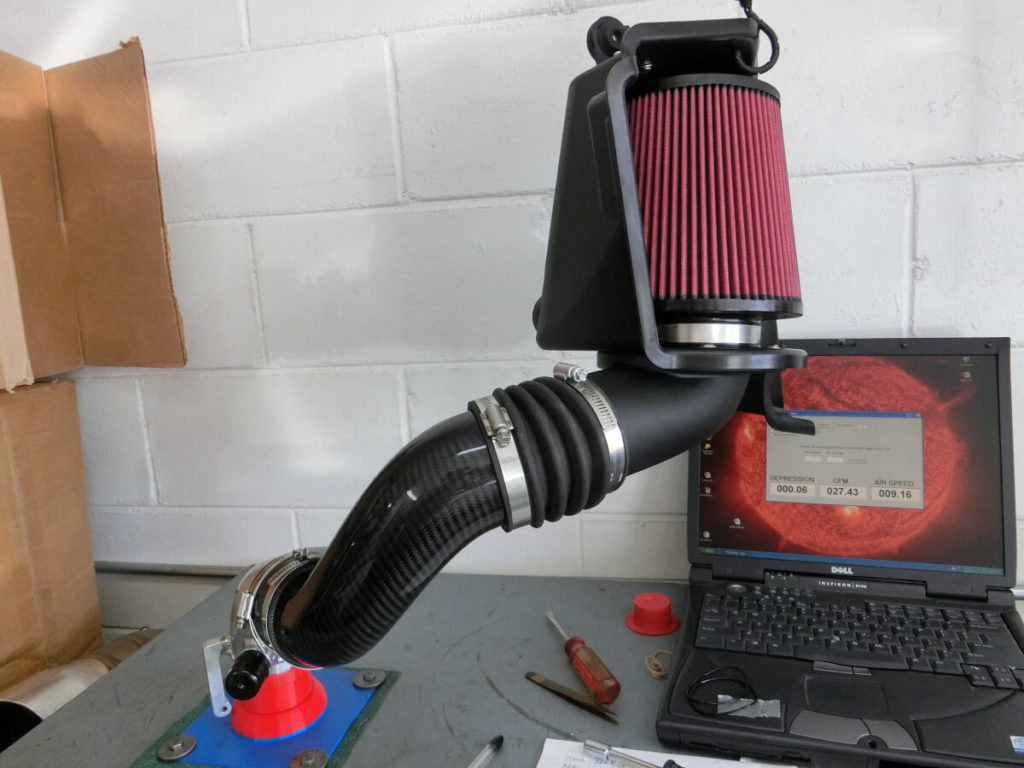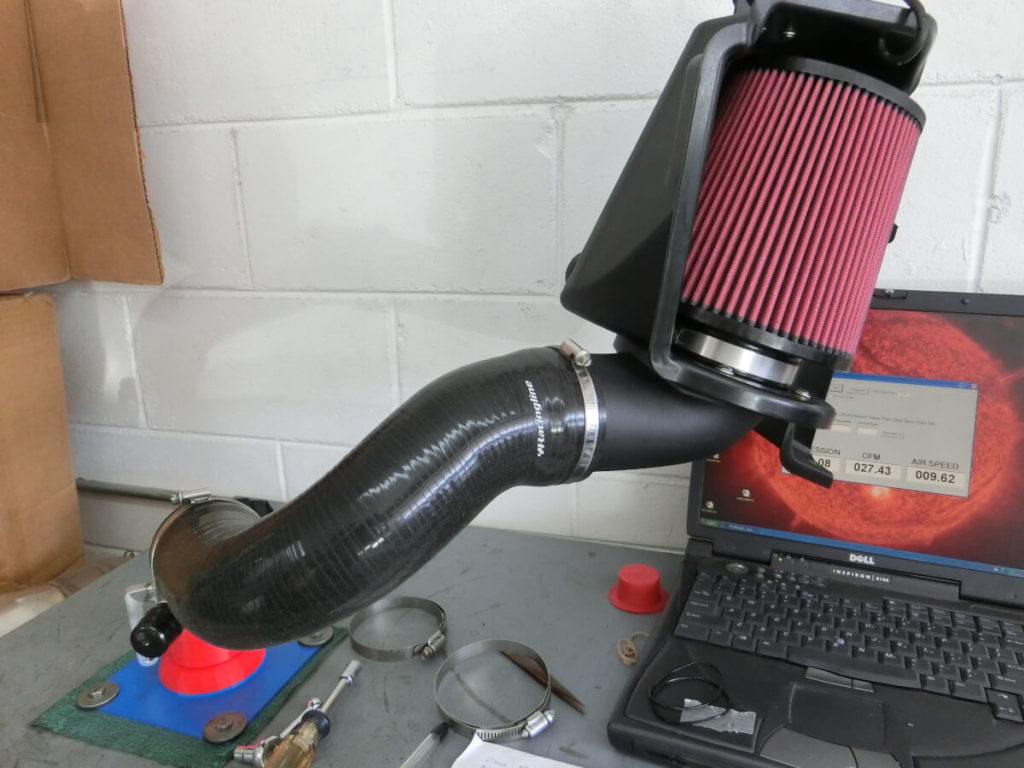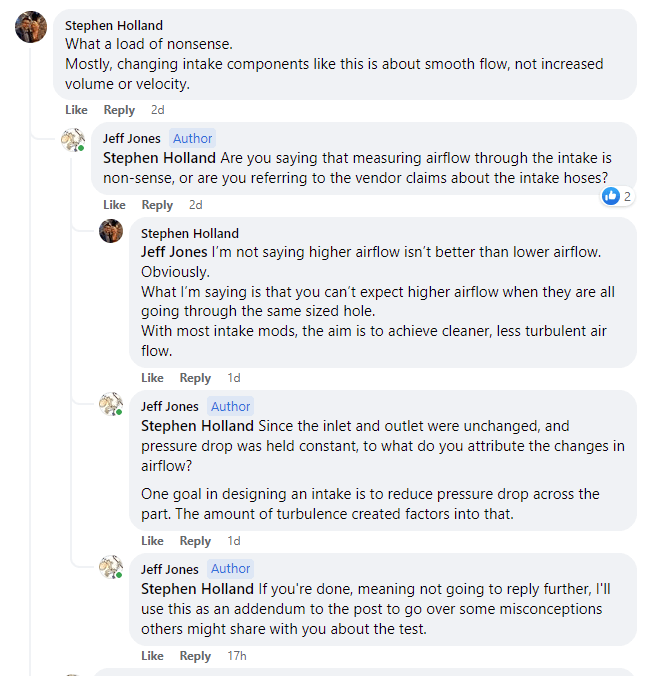Background:
The turbo inlet hose joins the stock airbox to the turbo inlet elbow. Replacement turbo hoses are available that are supposed to improve upon the performance of the stock accordion hose.
In this post, a selection of aftermarket turbo inlet hoses is flow tested and compared with the stock Mk7 GTI turbo inlet hose to see how airflow through an entire air intake is affected by the different products.

Performance Claims:
Some of the benefits attributed to the upgraded parts by product vendors are listed below:
034 Motorsport product –
- replacement for the unattractive and restrictive OEM corrugated plastic hose.
- The 034Motorsport Turbo Inlet Hose smoothly transitions from the intake to the turbo inlet pipe, providing increased airflow capability to support other power improving modifications.
- Maintains Smooth Inside Surface for Optimum Flow
APR product –
- designed to increase performance by letting the engine breathe more freely.
- Increased horsepower and torque
- Better throttle response
Racingline product –
- “The reinforced Inlet Hose has been engineered to increase air flow through to the turbocharger as the perfect compliment our VWR R600 Cold Air Intake or even the standard airbox.”
- “A simple fitment, it replaces the entire restrictive rear factory plastic ‘bellows’ pipe between the airbox and the turbocharger inlet.”
- “Back-to-back comparisons with the factory pipe on our flow bench reveals an impressive improvement in airflow, and makes this hose a great compliment to the R600 intake.”
- “Put simply, you’ll be wasting a chunk of the hard-gotten gains from your high-flow intake system if you leave this pipe standard.”
- “By taking away the standard plastic bellows pipe’s restrictive and turbulent airflow path between the intake and the turbocharger, the High-Flow Turbo Inlet Hose gives a worthwhile power gain.”

If the vendor claims are to be believed, upgrading this part will provide power gains among other benefits.
Test Procedure:
A flow bench is used to measure airflow through an intake system and the different turbo inlet hoses are changed out while keeping the rest of the setup constant.
Prior to testing the inlet hoses, the flow bench calibration is checked using a calibration plate. Testing is conducted at a depression of 28″ of H2O.
The turbo inlet hoses are tested by attaching them to an APR PEX open intake. The intake hose is also attached to a generic style aftermarket turbo inlet elbow, and the inlet elbow is attached to the flow bench using an adapter that simulates the compressor housing of an IS20/IS38 turbocharger.
Test Results:
The stock accordion hose is tested first to establish a baseline. It is found to flow 373 CFM @ 28″ of H2O.

Next, the APR Carbon Fiber inlet pipe is tested. It flows 378 CFM @ 28″ of H2O..

Next is the 034 Motorsport silicone inlet hose. It flows 383 CFM @ 28″ of H2O.

The last to be tested is the Racingline inlet hose. It flows 380 CFM @ 28″ of H2O.

The combined results for all of the tested products are shown on the following chart:

Conclusions:
All of the aftermarket inlet hose options show small airflow gains versus the stock GTI inlet hose.
Airflow improvement ranged from 1.3% – to 2.7%.
The claims made by the vendors for power improvement increased horsepower and torque, and better throttle response are unlikely to be detectable by a driver.
References:
Other Point of View:
Some concerns were raised by a fellow enthusiast about this test. For the benefit of others who may share Stephen’s concerns, I’ll address the points he brought up.

- Changing intake components is done to smooth airflow.
- This is a potential benefit. All of the aftermarket intake hoses that were tested had a smoother interior than the stock accordion hose.
- Changing intake components is not done to change the volume.
- This is not necessarily true. While the volume of an intake part shouldn’t be changed just for the sake of changing the volume, usually the volume is enlarged as this results in a lower volumetric flow rate through the part. Friction losses are primarily affected by airflow velocity, and lowering airflow velocity with a larger pipe can be beneficial.
- Changing intake components is not done to change air velocity.
- If improving flow performance is a goal, this statement is false. As pointed out in #2, air velocity is a primary factor affecting friction losses. If the goal is to improve the airflow through a part, altering the air velocity by lowering it has the potential to accomplish this. Think about the drag force that opposes your car the faster it goes – this test is evaluating the internal drag force of the intake hose.
- Cannot expect higher airflow when the outlet diameter is unchanged.
- This is false. The results of this test disprove this statement. Also, the wide range of intake flow results, all going through the same size adapter, is another example of this not being the case. Another obvious example of this statement not holding up is a catted versus catless downpipe. Each may exit a 3″ diameter pipe, but the presence of a catalytic converter significantly affects the airflow through the downpipe.

Do you have plans to test a runner flap delete kit? CTS Turbo claims thay create a substantial restriction on modified engines.
https://www.ctsturbo.com/product/cts-turbo-ea888-3-gen3-intake-manifold-flap-delete/
I probably won’t. It’s likely they never performed a before and after comparison, contacting them to find out how valid their claims are is something I’ve had in mind to do for a while. Once the stock IM flaps open there is a straight passage out of the runner, they don’t obstruct the airflow.